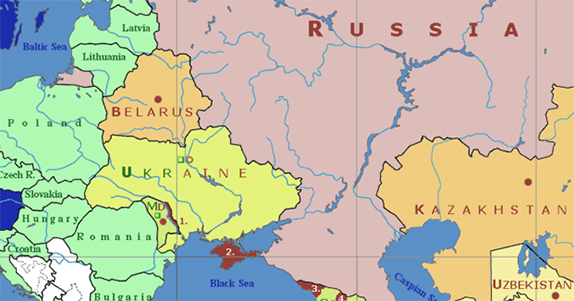
What Vladimir Putin is doing today in the Ukraine has a wealth of historical precedent in the New World. To understand how a few hundred—or a most several thousand—Russian soldiers succeeded in seizing Crimea without firing a shot, you could hardly do better than go back to the early 16th century and take a look at how Hernán Cortés’s 550 soldiers conquered the 25 million citizens of the Aztec Empire and how a decade later Francisco Pizarro’s 168 soldiers defeated the ruler of the Inca empire, the world’s largest country, without suffering a single casualty.
For a more recent precedent, look at how the United States used a show of military force to secure the secession of Panama and control of the Panama Canal Zone. In fact, the new state of Panama created in 1903 at the instigation of President Theodore Roosevelt bears more than a passing resemblance to the secessionist province of Crimea being created by Putin. Both have militarily strategic ports important to their sponsors but without a common border with them. With three times the area, Roosevelt’s Panama grab was actually a bit more ambitious than Putin’s Crimean seizure.
One of the more remarkable aspects of the Russian occupation of Crimea is that the Ukraine took no action to defend its province. Granted, Russia did send in a small number of combat soldiers. But the Ukraine has a modern army of 160,000 with warplanes and tanks. It had a network of military bases in Crimea and its own naval fleet based there. It had control of Crimea’s only link to Russia, a 12-mile-long ferry route. The only two roads tying the peninsula to the rest of the world both run through the Ukraine. All of the peninsula’s potable water and electricity are supplied by the Ukraine.
So how did Vladimir Putin pull it off? The same way Cortés and Pizarro made conquering the world’s largest and richest empires seem like a stroll in the bosque.
The formula goes like this. First, you strike when the central government is weak and divided. Ukraine had just undergone its third revolution in 23 years; the Incas were in the midst of a civil war; and discontent was rife in the Aztec empire.
Second, you capitalize on the failure of the government to create a regime that commands respect and loyalty. The Aztec and Inca leaders, like the generation of politicians and oligarchs ruling the Ukraine, were authoritarian, corrupt, incompetent, blood thirsty and living lives of opulence.
Third, you ally yourself with dissidents who want to use you to strike down their domestic enemies. Tribes ruled by the New World empires had lost their autonomy and were in the process of losing their identity. To save themselves, they took the initiative in seeking the Spaniards’ help. All Pizarro and Cortés had to do was say yes.
Similarly, the missteps of the Ukrainian government, the failure to provide adequate public services, discrimination against Russian-language speakers and panic about the future (deliberately fed by Russian propaganda) won Russia numerous allies not only in Crimea but also in eastern Ukraine.
Fourth, once you have used these dissidents to destroy the government, you turn on your own allies, destroy them and take over unfettered power. This is what Cortés and Pizarro did, and what Putin may well do.
In the decisive battle in Peru, according to 1491: New Revelations of the Americas Before Columbus—Charles C. Mann’s widely praised account of the western hemisphere at the time of the conquest—Pizarro with the help of indigenous foes of the government “routed a force fifty times larger than his own, won the greatest ransom ever seen, and vanquished a cultural tradition that had lasted five millennia—all without suffering a single casualty.”
Earlier Cortés used courage and cleverness to trounce the Aztecs, but again quoting from 1491, “all of his bold resolve would have come to nothing without the vast indigenous army whose leaders believed they could use the Spanish presence to catalyze the destruction of the [Aztec empire].” In the climactic battle for Mexico, in which an estimated 100,000 men died, Cortés led a force of about 300 Spaniards and 200,000 Indians.
Now wind forward four centuries. Roosevelt bought out the French Panama Canal company for $40 million and negotiated a treaty with Colombia to build the canal. But when the Colombian Senate rejected the treaty, Roosevelt did it his own way. He prompted a group of dissidents to secede and promised them that the United States would make sure their rebellion was a success.
Sure enough, when the dissidents declared Panama to be an independent country, the United Sates sent in a warship, the USS Nashville, to prevent Colombia from putting down the rebellion.
On Feb. 23, 1904, the new country of Panama that Roosevelt had just created agreed to give the United States control of the Canal Zone in return for $10 million.
Flora Hill and Clifford G. Gaddy—who had a discussion with Putin and other Russian leaders and intellectuals at a major international conference—wrote in the Jan.-Feb. 2012 issue of the National Interest:
Any effort to understand Vladimir Putin must begin with the man of history. For Putin, the interpretation and reinterpretation of history is a crucial matter. History was his favorite subject in school, and he remains an avid reader today. He appreciates the power of ‘useful history,’ the application of history as a policy tool, as a social and political organizing force that can help shape group identities and foster coalitions.
It would hardly be surprising, then, if Putin had learned the lessons of Cortés, Pizarro and Roosevelt.
(Image credit: Geopolitcs of South Russia, according with the CIA facts books, derivated on a map backgroud by David Liuzzo.)



Responses to “What the New World Taught Putin About Land Grabs”